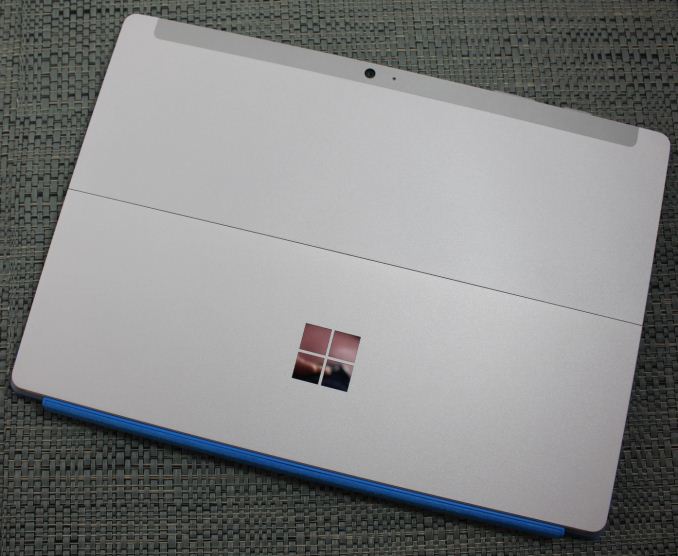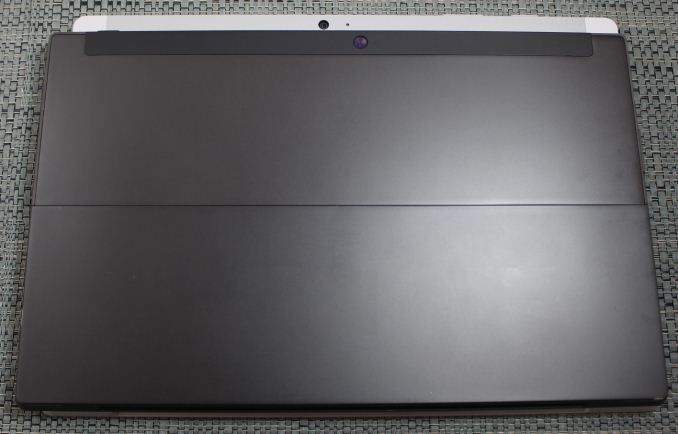The Surface 3 Review
by Brett Howse on May 4, 2015 9:00 AM EST
The Surface lineup for Microsoft has been extremely interesting to watch. What first launched in October 2012 as the Surface RT has been constantly iterated upon, and of course the Surface Pro line has evolved even faster. Surface Pro 3 has finally provided Microsoft with something that critics and consumers alike seem to have bought in to, and sales have been very strong since the Pro 3 was launched on May 20th 2014. However there has always been questions about the “consumer” version of Surface. Surface RT was, frankly, a sales disaster. The much improved Surface 2 fixed many of its shortcomings, but certainly did not set the world on fire. So now we have the third generation Surface, aptly named the Surface 3. There are a pile of changes that Microsoft has made to this generation of device, and obviously their hopes are that Surface 3 will be as popular as the Surface Pro 3 has been, but extending the device back down to a lower price point.
That price point is important. As much as the Surface Pro 3 has gained its share of fans, it is far from cheap. The most inexpensive model starts at $799, and for that you still do not get the keyboard. Surface 3 moves that bar down significantly, and the starting price is the exact same as the original Surface RT, at $499. Microsoft had to trim down the Pro model to hit this price point, but the cuts were well placed.
 Surface RT compared to Surface 3
Surface RT compared to Surface 3
I think looking at the Surface 3 in a vacuum would be improper, since the device now is really an evolution of the previous two Surface models. From a build quality standpoint, the original Surface RT was top notch, with its VaporMg case, the revolutionary kickstand, and high attention to detail for all of the aspects from buttons to display. I think in 2015 it is pretty obvious what the shortcomings of the Surface RT were though. Performance was less than acceptable with the Tegra 3 SoC on board, and Surface RT was handicapped with the confusingly named Windows RT operating system and the lack of software compatibility that goes with using an ARM CPU instead of traditional x86. Surface 2 fixed the performance issue by moving to NVIDIA’s Tegra 4 SoC, and while not the outright fastest tablet chip, it was at least in the ballpark. However it kept the Windows RT operating system at a time when everyone else had abandoned it.
Surface 3 has fixed that final issue and at the same time made some amazing improvements to the overall design and feel. Full x86 Windows is on tap, for better or for worse, and powered by a brand new SoC. This must be a special moment in history where a Microsoft built device is the launch vehicle for a brand new product from Intel. The Surface 3 is powered by the 14nm Intel Atom x7, in this case the x7-Z8700 model which is the current top of the line Atom processor. Codenamed Cherry Trail, this is the massaged Bay Trail cores now built on Intel’s now mature 14nm FinFET process, and they include the same GPU cores as Broadwell.
| Microsoft Surface Comparison | |||
| Surface 3 (Base) | Surface 3 (High) | Surface 2 | |
| Size | 10.52 x 7.36 x 0.34 inch 267 x 187 x 8.7 mm |
10.81 x 6.79 x 0.35 inch 275 x 173 x 8.8 mm |
|
| Weight | 1.37 lbs - 622 g | 1.49 lbs - 675 g | |
| Display | 10.8-inch ClearType Full HD Plus 1920x1280 resolution, 3:2 ratio 10-point multi-touch Surface Pen Support |
10.6-inch ClearType Full HD 1920 x 1080 resolution, 16:9 ratio 5-point multi-touch |
|
| Battery | 28 Wh, 13 W AC Adapter | 31.5 Wh, 24 W AC Adapter | |
| Storage | 64GB | 128GB | 32GB or 64GB eMMC |
| RAM | 2GB | 4GB | 2GB |
| CPU | Atom x7-Z8700 Quad Core 14nm 1.6 GHz Base Frequency 2.4 GHz Burst Frequency |
NVIDIA Tegra 4 4x ARM Cortex-A15 @1.7GHz |
|
| WiFi | Marvell 802.11ac + BT 4.0 LTE Models at a later date |
802.11n + BT 4.0 | |
| Ports | USB 3.0, Mini-DisplayPort, microSD, Micro USB charging, 3.5mm Headset Jack |
USB 3.0, micro-HDMI, microSD, proprietary charging | |
| Software | Windows 8.1 Office 365 Personal with 1TB OneDrive (1-year) |
Windows RT 8.1 Office 2013 RT Home & Student Edition |
|
| Front Camera | 3.5 MP | 3.5 MP | |
| Rear Camera | 8.0 MP with Autofocus | 5.0 MP | |
| Operating System | Windows 8.1 64-bit | Windows RT 8.1 | |
| Warranty | 1-year limited | 1-year limited | |
| Price | $499 | $599 | $449 |
In addition to the new SoC, Surface 3 can be purchased with up to 128 GB of eMMC storage, and the higher storage models also come with 4 GB of RAM. This compares to the base model which is 2 GB of RAM and 64 GB of storage, which is already one of the big improvements Microsoft has made with Surface. 32 GB of storage on a Windows tablet is really the bare minimum required, and the move to 64 GB as the base is going to make this tablet far more usable. You can of course add more storage with a micro SD card, but until Windows gets the great SD card support from Windows Phone, it still means that you need to manage your storage more than you should have to.
There are so many changes with the Surface 3 that really, this is likely the Surface that most people wanted from day one, but did not know it. First up is the new (again) kickstand.










265 Comments
View All Comments
khanikun - Friday, May 8, 2015 - link
I have an SP3 and it's big selling point over essentially everything you mentioned, the ability to actually make it a tablet. I don't need a keyboard strapped on the thing 24/7, nor do I want to put the keys in harms way when converted into tablet form.I use it like a laptop when I hit my destination and I rip the keyboard off it, when walking around or having it put into my tablet mount in the car. If it were a convertible laptop, I probably would have lost a few keys by now.
Rebelismo - Tuesday, May 12, 2015 - link
Yeah. Lack of apps... That's a good one.There is a clear chasm nowadays between content consumers, and professional users. It seems that MOST people would be fine with a social media content device. The way I see it, the Surface line was made for engineers, designers, scientists, artists etc. If you're worried that the windows store might not have Snapchat, then please get yourself a nice android or ios phablet.
eagle63 - Sunday, May 17, 2015 - link
"...the Surface line was made for engineers, designers, scientists, artists etc...." Those people primarily use Macs, not Windows. Windows is for corporate-types who push spreadsheets around all day. :) Obviously I'm generalizing but I'm not that far off the mark.If you're looking at a Windows tablet and honestly intend to use it as a tablet, then yes there is a remarkable lack of apps - I actually can't believe you would think otherwise. (have you used iOS or Android before??) If your primary goal is a professional/business device, then you're probably set - but you're also probably looking at the Pro model, not this one. So I think the app argument (for this device at least) is absolutely valid and relevant.
JRX16 - Wednesday, May 27, 2015 - link
"Those people primarily use Macs, not Windows. Windows is for corporate-types who push spreadsheets around all day. :) Obviously I'm generalizing but I'm not that far off the mark."This... And while some will point out that engineering and scientific organizations will be filled with Windows machines on desks and cubicles, that's a business decision to cut initial costs. The engineers and scientists' personal machines are more often then not Macs.
JoeOliano - Wednesday, June 17, 2015 - link
I'd say it's 50/50Depends on the scientist and the area of research. I never understood the desire for macs and I'm a scientist. They are just sleek and fancy. Only (bio)informatics would benefit from the mac productivity wise. The rest, not so much. And they could do just as well with linux, just no linux tablets on the market ;). That said, the surface line runs ubuntu flawlessly as dual boot!
illegaloperation - Monday, May 4, 2015 - link
Why do you factor in the price of the dock? Does the HP Spectre x360 comes with a dock?illegaloperation - Monday, May 4, 2015 - link
1. The dock is more of an optional accessory than anything. I don't know why you factor in the price of the Dock.2. The HP Spectre x360 weigh 3.26 lbs. That's the weight of the Surface 3. If weigh and portability isn't a concern for you, why even get a laptop? Just get a desktop and you'll get even more for your money.
illegaloperation - Monday, May 4, 2015 - link
I intended to say "over twice the weight of the Surface 3"NeatOman - Monday, May 4, 2015 - link
$599 model + keyboard and pen puts it at $780, i don't think anyone cares to much about the dock for the surface or any other laptop unless they use it for work and it is also powerful. But for $780 i think its a bit slow (despite the NAND being about twice as fast as the 64GB model) at about half the speed if not less at times, it is not worth it.I would just pick up a UX305 with the Core M-5Y10 8GB/256GB for $699 like they said in the article. But if it was $499 for the 4GB/128GB model then i would have no problem recommending it as an option with caution. The surface pro 3 on the other hand i think is still a great PC.
romprak - Tuesday, May 5, 2015 - link
I am a big fan of the UX305! But it really isn't comparable, for one the S3 is a tablet - and there are some good applications for having that pen. If you are going to compare it to the UX305, at least remove the pen from your comparison price to knock the price of the S3 down to $730.I have a S3 Pro, and the reason I cannot go to something like the UX305 is that after using the 3:2 aspect ratio screen, I have a hard time coding on a 16:9 display with the lack of vertical space for code. I wish PC manufacturers didn't start using a video oriented aspect ratio for productivity machines :(